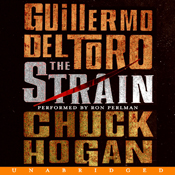
 The Strain
The Strain
By Guillermo del Toro and Chuck Hogan; Read by Ron Perlman
Audible Download – 13 hours 36 mins [UNABRIDGED]
Publisher: Harper Audio
Published: 2009
Themes: / vampires / scientific thriller / horror / New York / mythology / medical mystery
Yes, it’s another book about vampires. But wait, don’t shrug it off just yet. Several things set The Strain apart from the glut of vampire novels flooding the market of late. First, it’s co-written by movie director Guillermo del Toro, whose past film successes include the vampire flick Blade II, the comic-book adaptation of Hellboy, and the mythological Pan’s Labyrinth. He’s also heading up the forthcoming film adaptation of J.R.R. Tolkien’s The Hobbit. Furthermore, The Strain takes a more sobering view of the undead, divorced from the romanticism weighing down the vampire genre.
The Strain begins when a plane lands at JFK airport with almost all its passengers struck dead. The Center for Disease Control calls in its chief investigator Ephraim Goodwether, newly divorced and newly sober, to look into the matter. Mysteries abound when the passengers’ bodies go missing from the morgue, the few survivors begin acting strangely, and a coffin-like trunk inexplicably vanishes from the plane’s cargo hold. Ephraim and his partner Nora, with whom he’s had some past romantic involvement, find unlikely aid in the guise of pawn shop owner Abraham Setrakian, an aged Holocaust survivor who carries an odd staff with a silver wolf’s-head handle. The old man explains that a centuries-old conflict between vampire tribes is about to burst forth onto the streets of New York.
And indeed it does. The narrative frequently shifts away from the main storyline to tell the stories of men and women infected with a strange virus, whose vector is a disgustingly pulsating capillary worm. Initial side effects resemble a mild flu and include sore throat and slight disorientation. But this is only the beginning. The sore throat, it turns out, heralds the growth of a new sinister organ, a long tendril-like apparatus under the tongue tipped with a deadly stinger, which in turn infects other humans. Other vampiric characteristics soon manifest, including the whitening of gums, an aversion to sunlight, and immunity to most forms of attack.
The premise is intriguing, especially since it presents a more scientific approach to the undead than most other vampire novels, except perhaps Richard Mathesen’s superior I Am Legend. Unfortunately, the actual story unfolds too slowly and spasmodically, and lacks evidence of any real structural forethought on the part of the authors. Del Toro originally pitched the idea as a TV show, and evidence of his screenwriting background can be found in the scene headings affixed to each section and in the many entertaining but ultimately superfluous vignettes of violence. The suspense sequences are spine-tingling and the action scenes hair-raising, but most of them do little to further the story.
The book’s shining gem is the character of Abraham Setrakian, whose harrowing escape from Nazis and forces even more sinister we learn throughout the book in flashback sequences. Del Toro’s interest in mythology and folklore take center stage, and provide the most compelling moments of the book.
It’s difficult to know how the division of labor fell between Guillermo del Toro and Chuck Hogan in writing The Strain, but my impression is that del Toro provided the concept and perhaps wrote some of the pivotal scenes, while Hogan did the heavy lifting of filling in the gaps and pulling the whole thing together. This should have been a good thing, since Chuck Hogan is an acclaimed best-selling author. However, writing good speculative fiction requires a certain sensitivity and perspective that I believe Hogan lacks, although this is only a guess on my part since I’ve read none of his other work. Del Toro has keener vision as a storyteller, at least as seen in his films, though these skills don’t necessarily translate to the written word. Since the cover bears both their names, both del Toro and Hogan must bear some blame for crafting a less-than-stellar novel.
The Strain is narrated by actor Ron Perlman, who incidentally also played a role in del Toro’s Blade II. Particularly in works of suspense and horror, a good voice actor can make the difference between scenes that leave you gripping the arms of your chair and scenes that make you laugh out loud by virtue of their inadvertent cheesiness. I’m pleased to report that Perlman’s voice work in The Strain had the former impact on me. His intonations are pitch-perfect, and he snarls out the vampiric growls and moans with enough force and feeling to chill the blood.
The Strain is the first in a trilogy of the same name, as can be seen in the novel’s grim and hurried ending. As Dante Hicks says of The Empire Strikes Back in Clerks, “it ends on such a downer.” That said, the ending brought significant changes to the lives of several pivotal characters who, despite the spotty storytelling, I’ve grown to care about, and I’ll probably read the sequel when it hits the audio airwaves next year.
Posted by Seth Wilson